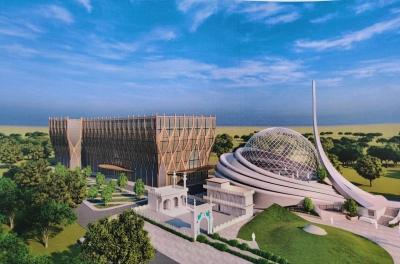Ayodhya: The construction of a mosque in Ayodhya is likely to start after the holy month of Ramzan.
The Ayodhya Development Authority (ADA) has given clearance to the mosque complex layout in Dhannipur village in a recent board meeting.
Nitish Kumar, district magistrate and chairman of ADA, Ayodhya, said, “All pending clearances to Ayodhya’s mosque cum complex project have been cleared in the recent board meeting. The sanctioned layout of the mosque will be handed over to the Sunni Central Waqf Board (SCWB) in the next couple of days after completing a few formalities.”
The SCWB called the development a big move and said it will call a meeting, probably after Ramzan, in this context.
Athar Hussain, secretary Indo Islamic Cultural Foundation (IICF) – the trust formed by SCWB to look after the construction in Dhannipur-said, “We will convene a meeting after Ramzan where we will finalise the plan to start construction. In the same meeting, we will also chalk out the final date to begin construction of the mosque complex.”
The holy month of Ramzan is likely to start from March 22 and conclude April 21.
On November 9, 2019, the Supreme Court’s Constitution Bench permitted the construction of a temple in Ayodhya at the site where the 16th Century Babri Masjid once stood and was brought down by ‘Kar Sevaks’.
The apex court, in the same judgment, had also asked the government to allot a “prominent and suitable” five-acre plot in Ayodhya for the construction of a mosque in lieu of the Babri Masjid.
While the board’s clearance has paved the way for the construction of the mosque, the SCWB has maintained that it did not want to associate the upcoming mosque with the disputed 16th Century structure that was brought down December 6, 1992.
Hence, they said, it would not be named after any Mughal emperor.
Athar Hussain said the mosque cum complex will be named after freedom fighter and revolutionary Maulvi Ahmadullah Shah Faizabadi. It will include a mosque, hospital, community kitchen, and museum among others.
“The maximum area would be allocated to the hospital. We plan to develop a multi-specialty hospital that would be equipped with state-of-art facilities. The entire hospital will be established in two phases. In the first phase, arrangement for 100 beds would be made while in the second phase, 100 more beds will be added. The hospital will offer the best treatment in cancer care, transplants, spine, heart, robotics, orthopaedics, emergency and others,” he added.
Professor S.M. Akhtar, a Lucknow-based architect-cum-town planner and founder dean, faculty of architecture, Jamia Millia Islamia University, Delhi, has been appointed by the trust to design the mosque.
Besides, the trust has also appointed renowned historian, international relations expert and chronicler of Indian cuisine Professor Pushpesh Pant as consultant curator of its archival museum that would be a part of the mosque complex.
The specialty hospital, community kitchen and a museum will be housed in a multi-storey vertical structure. These will be metres away from the mosque and a century-old Sufi shrine will be in between.
The mosque, meanwhile, will be spherical in shape with a capacity to accommodate 2,000 ‘namazis’ or worshippers at a time.
It will be four-times bigger than the Babri Masjid.
The hospital complex will be six-times the size of the mosque. The mosque will be built on 3,500 square metres of land while the hospital and other facilities will straddle an area of 24,150 square metres.
The building will be zero-energy to convey a message on climate change. All power demands in the mosque will be met with the help of solar panels and there will be no electricity connection.
A green patch will be developed and saplings will be procured from all over the world, including Amazon rainforest, places where the bushfire took place in Australia and other geographical locations in India.
There is no detailed plan yet to collect contributions for the project. Two separate bank accounts have been created to collect money for the construction – the first for the mosque and the second for other structures.







































